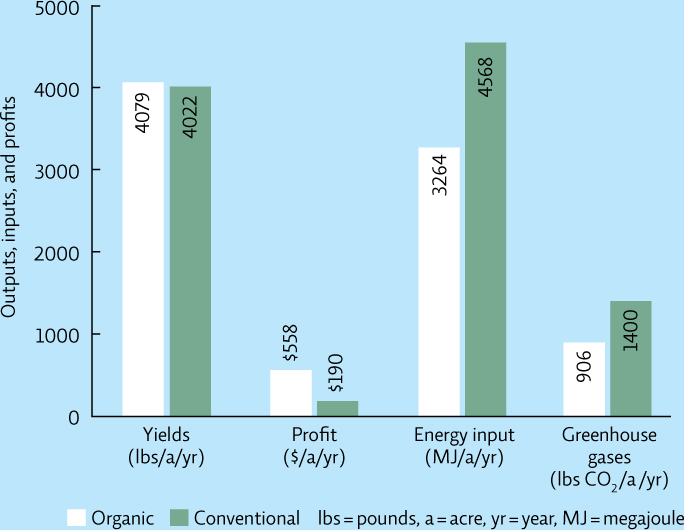18.7 Analyzing The Science
The data in the following graph come from the Farming Systems Trial (FST) research study conducted by the Rodale Institute in Pennsylvania. This side-by-side comparison of corn and soybeans grown under organic and industrial agricultural systems was started in 1981 and is one of the longest-running studies of its kind.
INTERPRETATION
Question 18.11
What does this graph show?
Question 18.12
Calculate the following for conventional and organic systems in both imperial and metric units: profit per unit of yield; energy input per unit of yield; and greenhouse gas emissions per unit of yield. How do the two systems compare for these three parameters?
Question 18.13
According to the Food and Agricultural Organization of the United Nations, “Organic agriculture has the potential to secure a global food supply, just as conventional agriculture does today, but with reduced environmental impact.” How does the data from the FST study support this statement?

331
ADVANCE YOUR THINKING
Hint: To answer the following questions, it might be helpful to access the actual Farming Systems Trial report at rodaleinstitute.org/our-work/farming-systems-trial/farming-systems-trial-30-year-report.
Question 18.14
According to the FST report, even in drought years, the yields for organic corn were approximately 31% greater than for conventional (non-drought-resistant) varieties. At the same time, genetically engineered drought-tolerant varieties had yields that were no more than approximately 13% greater than conventional (non-drought-resistant) varieties. Why might this be the case? Why is this an important finding?
Question 18.15
The FST report also indicates that crops grown using organic methods produced yields equivalent to conventional crops even though they had more weed competition in their fields. Why might this be the case? What makes this an important finding?
Question 18.16
According to the FST report, the largest energy input in organic systems was diesel fuel, while the largest for conventional systems was nitrogen fertilizer. How could these energy inputs be changed to make both systems more economically and ecologically sustainable?